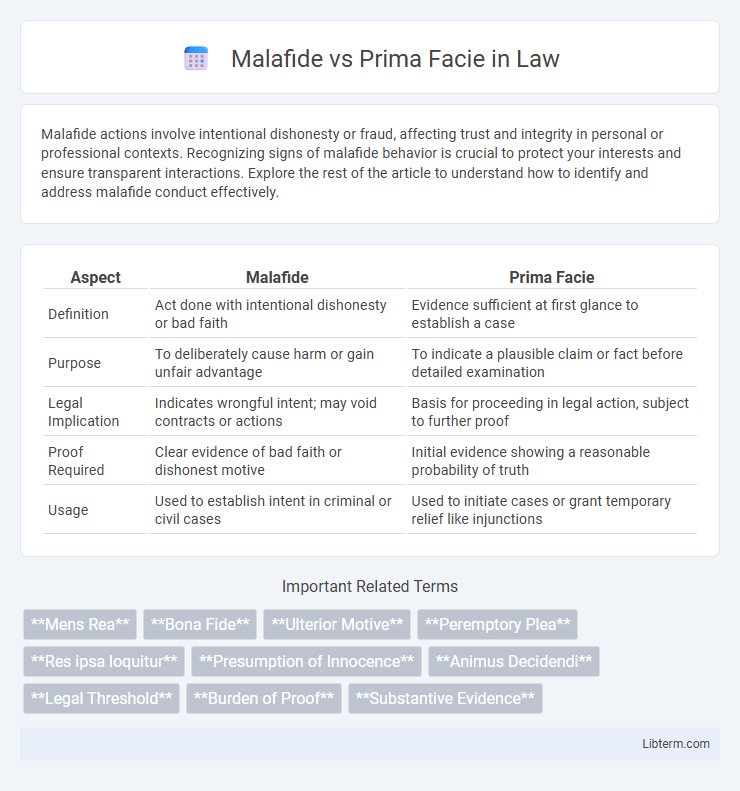Malafide actions involve intentional dishonesty or fraud, affecting trust and integrity in personal or professional contexts. Recognizing signs of malafide behavior is crucial to protect your interests and ensure transparent interactions. Explore the rest of the article to understand how to identify and address malafide conduct effectively.
Table of Comparison
| Aspect | Malafide | Prima Facie |
|---|---|---|
| Definition | Act done with intentional dishonesty or bad faith | Evidence sufficient at first glance to establish a case |
| Purpose | To deliberately cause harm or gain unfair advantage | To indicate a plausible claim or fact before detailed examination |
| Legal Implication | Indicates wrongful intent; may void contracts or actions | Basis for proceeding in legal action, subject to further proof |
| Proof Required | Clear evidence of bad faith or dishonest motive | Initial evidence showing a reasonable probability of truth |
| Usage | Used to establish intent in criminal or civil cases | Used to initiate cases or grant temporary relief like injunctions |
Introduction to Malafide and Prima Facie
Malafide refers to actions or intentions characterized by dishonesty or bad faith, often aimed at deceiving or causing harm. Prima facie denotes evidence that, on the face of it, is sufficient to establish a fact or a case unless disproved. Understanding the distinction is crucial in legal and ethical contexts, where malafide actions undermine trust, while prima facie evidence facilitates preliminary judgments.
Defining Malafide: Meaning and Legal Implications
Malafide refers to actions or intentions that are deliberately dishonest or fraudulent, showing a clear intent to deceive or harm, which distinguishes it from prima facie evidence that merely suggests a fact until disproved. In legal contexts, malafide conduct involves bad faith, indicating that a party knowingly violated laws or rights, often leading to harsher penalties or loss of credibility in litigation. Courts scrutinize malafide behavior rigorously to uphold justice, preventing abuse of legal processes and protecting the integrity of contractual or statutory obligations.
Understanding Prima Facie: Concept and Application
Prima facie refers to evidence or facts that are sufficient to establish a case or claim unless disproved, serving as an initial proof in legal proceedings. This concept allows courts to presume a fact is true based on the presented evidence until contradictory evidence emerges. Understanding prima facie is crucial for determining whether a claim warrants further examination or dismissal at the preliminary stage.
Key Differences Between Malafide and Prima Facie
Malafide refers to actions taken with deliberate intent to deceive or act in bad faith, often implying fraudulent or dishonest motives. Prima facie is a legal standard indicating that evidence is sufficient to establish a fact or case unless disproven, signifying an initial appearance of truth. The key difference lies in malafide emphasizing intent and wrongful purpose, whereas prima facie concerns the sufficiency of evidence at first glance without implying intent.
Legal Significance in Judicial Proceedings
Malafide actions in judicial proceedings indicate intentional dishonesty or fraud, leading to adverse inferences and potential penalties for abuse of process, thereby severely undermining the credibility of the party involved. Prima facie evidence establishes a case based on initial appearances, enabling courts to proceed with detailed examination or trial, as it presents sufficient facts to support a claim unless disproved. The distinction between malafide conduct and prima facie evidence critically influences judicial discretion in assessing the legitimacy and weight of submissions or defenses.
Examples of Malafide in Legal Cases
Malafide actions in legal cases refer to intentional wrongdoing or bad faith, such as when a government official manipulates evidence to deny a citizen's rightful claim, exemplified in cases like Maneka Gandhi v. Union of India where malafide use of power was evident. Another example includes employers terminating employees under false pretenses to avoid legal obligations, demonstrating malafide intent to circumvent labor laws. Courts distinguish malafide conduct from prima facie evidence, which simply shows facts at first glance without proving bad faith.
Illustrations of Prima Facie Evidence
Prima facie evidence refers to the initial, sufficient proof required to support a case unless disproven, exemplified by a signed contract demonstrating agreement terms or a credible eyewitness testimony linking a suspect to a crime scene. In contrast, malafide denotes actions taken with intentional bad faith or dishonesty, often revealed through inconsistent statements or fabricated documents. Courts rely on prima facie evidence to establish a foundation for claims, while malafide intent must be proven to demonstrate fraudulent or wrongful conduct.
Malafide vs Prima Facie: Impact on Case Outcomes
Malafide actions signify intentional wrongdoing or bad faith, strongly influencing case outcomes by undermining credibility and often resulting in dismissal or penalties. Prima facie evidence establishes a basic threshold of proof sufficient to support a claim or defense, prompting further examination rather than immediate judgment. The distinction between malafide intent and prima facie evidence shapes judicial decisions, as malafide conduct damages the party's position while prima facie findings guide the trajectory of legal proceedings.
Jurisprudential Perspectives and Interpretations
Malafide and prima facie represent distinct jurisprudential concepts where malafide denotes an intent or motive characterized by dishonesty or bad faith, while prima facie refers to evidence sufficient to establish a fact unless disproved. Jurisprudential interpretations emphasize that malafide actions undermine the integrity of legal processes, often requiring a higher threshold of proof to establish intent. Prima facie cases provide an initial basis for legal arguments, prompting deeper judicial scrutiny to confirm or rebut presumptions during litigation.
Conclusion: Why Distinguishing Malafide and Prima Facie Matters
Distinguishing malafide and prima facie is crucial in legal and contractual contexts because malafide indicates intentional bad faith or deceit, whereas prima facie refers to evidence that is sufficient to establish a fact unless disproven. Misinterpreting prima facie evidence as malafide conduct can lead to wrongful accusations and undermine justice. Clear differentiation ensures fair assessment of intent and evidence, maintaining the integrity of judicial and administrative decisions.
Malafide Infographic

 libterm.com
libterm.com